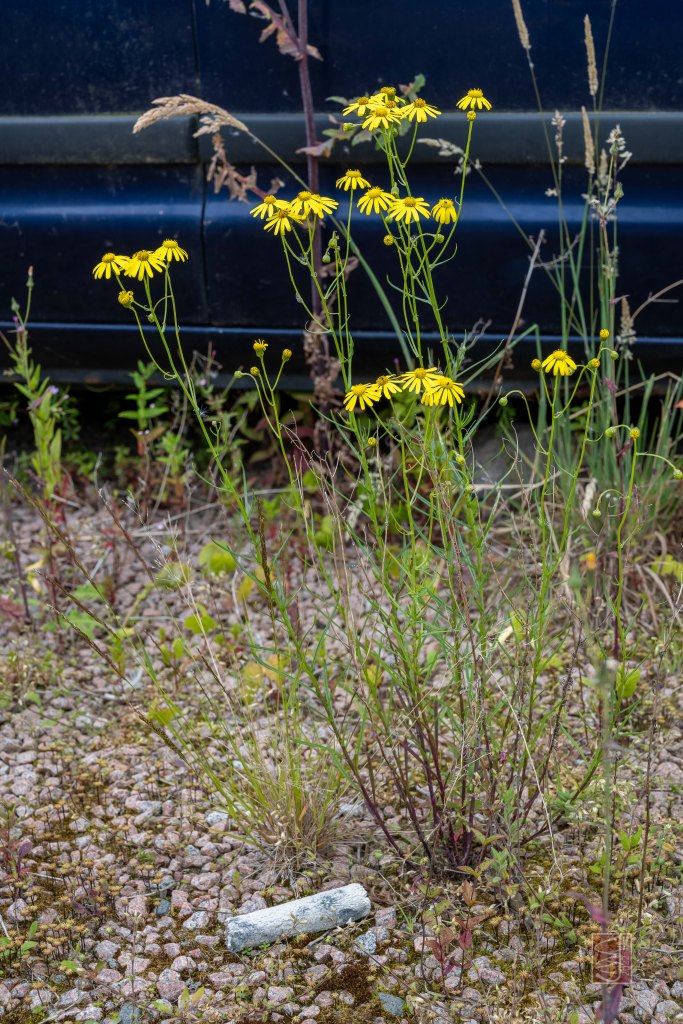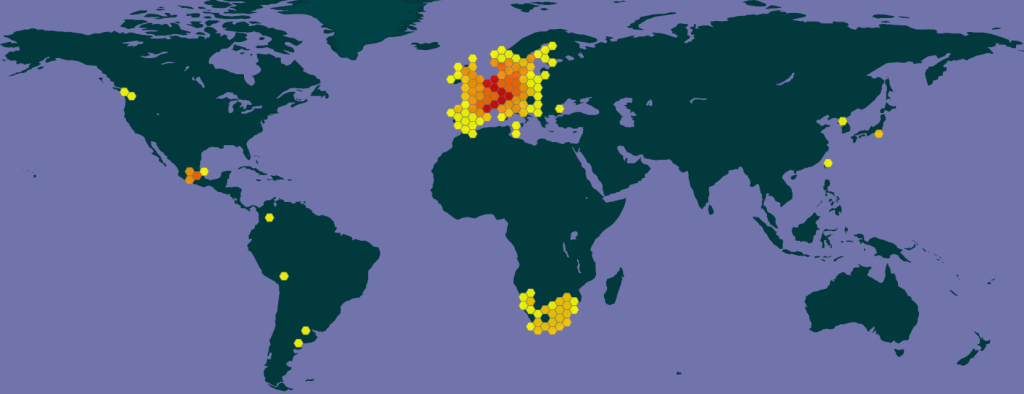We first saw this plant in 2016, at a car park in north Edinburgh. Identification took a while as the handbooks we were using did not include up-to-date information on distribution. We were fairly sure this was a Senecio and its flowers looked like Senecio squalidus, the Oxford Ragwort. However, its leaves were narrow and without lobes, quite unlike those of S. squalidus.

Senecio inaequidens in flower, Bon Accord Crescent Lane in Aberdeen, Scotland. Photo: © Chris Jeffree.
Since then, we have seen the species several times and records have increased substantially. So I decided it is a well-deserving candidate for Plant of the Week.
Senecio is a very large genus within the daisy family (Asteraceae). In the fourth edition of his flora, Stace (2019) shows 16 species in the British Isles but there are over 1,200 in the world. They include the ragworts and the groundsels, and they mostly have yellow daisy-like flowers.
This one is a South African plant that has become widely distributed throughout Europe and is considered by some to be ‘an invasive alien’. It is thought to have arrived in imported wool. This view is quite plausible as it looks identical to one of the several Senecio species that Ida Hayward found near her uncles’s woollen mill in Galashiels (Hayward and Druce 1919). She called it Senecio lautus and said it came from Australia. However, according to Stace (2019) and others, S. lautus is a synonym for S. inaequidens. Indeed, there is a S. lautus in Australia, and so it seems that the oft-repeated view that S. inaequidens came only from South Africa requires further checks.
There is another Scottish connection. The first European record is Scottish, from 1834 in Fife, a time when the manufacture of wool products was well-developed throughout Scotland, including the towns of Stirling and Kinross in Fife (Groom; https://electricscotland.com/history/industrial/industry9.htm).

Senecio inaequidens in Straik Road, Westhill, Aberdeenshire alongside a traditional letterbox (note the Royal Cypher GR: the letterbox was established in the reign of King George VI). Photo: © Chris Jeffree.
As with many Ragworts the plant is poisonous because it contains pyrrolizidine alkaloids. These compounds cause liver failure in mammals. The chemical defences of ragworts appear to be well-developed: they are remarkably devoid of insect pests. However, larvae of the cinnabar moth (Tyria jacobaeae) are immune to ragwort poisoning and so the moth has been introduced into Australia and South Africa to effect control. The best place to read about ragweed toxicity is Dimande et al. 2007, in an investigation of the poisoning of cattle in South Africa. This thorough piece of work not only describes experiments in which rats were poisoned to determine the clinical signs and pathology of poisoning, but also has a very good botanical description of the species.
It grows on waste ground, railway tracks, car parks and major roads. Its seeds are readily dispersed by wind and may be carried in the wake of fast-moving trains and vehicles. It is widespread through Europe, and is featured in the French flora of wastelands (Muratet et al. 2017).
The recent spread of Senecio inaequidens in Britain has been rapid. Stace and Crawley (2015) refer to a ‘second wave’ of invasion coming from France. It appeared near Dover in 1978, remaining there for 15 years, and then spread over many parts of southern England. Stace and Crawley hint that the second wave may be due to rail traffic between France and Britain when the Channel Tunnel opened in 1994. There is a general tendency for the species to be seen along major roads (see the map below, especially Ireland), suggesting an onward spread by road vehicles, although this may be simply because botanists have seen it from their car windows. Plant recording is not an exact science!

Senecio inaequidens, maps made using the BSBI website. Rapid expansion of the species is demonstrated.
Can it be described as an ‘invasive alien’ ? To fit this definition an organism must do harm to the natural environment and the ecosystems within. It is not on the UK list of 36 invasive alien plants, and I suspect it will never be. It does not dominate, like American Skunk Cabbage, Himalayan Balsam and Giant Hogweed. Similar to Senecio squalidus, the Oxford Ragwort, it usually exists in small populations, adding a splash of colour to the otherwise-grey urban landscape. It may be more properly regarded as a synanthropic species, i.e. one living in association with humans. There are many of these, common in all surveys of the urban flora yet rather rare in rural habitats.

Senecio inaequidens, global distribution according to GBIF. But S. lautus is a synonym for S. inaequidens, and occurs in Australia and New Zealand.
What about its name, Senecio inaequidens DC ? Senecio comes from the Latin for old man because of the hoary pappus of hairs (from sen-, senic-, senex old man). The specific name inaequidens means ‘irregular teeth’ in Latin and refers to the margins of the leaf blade (but in this case surely a misnomer as the leaves are not toothed).
DC. is the standard abbreviation of the botanical author Augustin Pyrame de Candolle (1778-1815), the Swiss botanist credited for introducing the word ‘taxonomy’ and carrying out experiments from which the existence of the ‘biological clock’ was inferred.
References
Dimande AF, Botha CJ, Prozesky L, Bekker L, Rösemann GM, Labuschagne L, Retief E. The toxicity of Senecio inaequidens DC. 2007 J S Afr Vet Assoc. Sep;78(3):121-9. doi: 10.4102/jsava.v78i3.302. PMID: 18237033. https://journals.jsava.aosis.co.za/index.php/jsava/article/view/302
https://electricscotland.com/history/industrial/industry9.htm
Groom QJ (Accessed 21/07/2022). Species account: Senecio inaequidens. Botanical Society of the British Isles, bsbi.org.
Hayward IM and Druce GC 1919 The Adventive Flora of Tweedside. T. Buncle and Co., Arbroath.
Muratet A, Muratet M, Pellaton M (2017) Flore des friches urbaines . Editions Xavier Barral
Stace CA and Crawley MJ 2015 Alien Plants. New Naturalist Library No. 129. Harper Collins.
Stace CA 2019 New Flora of the British Isles. 4th Edition. C & M Floristics.